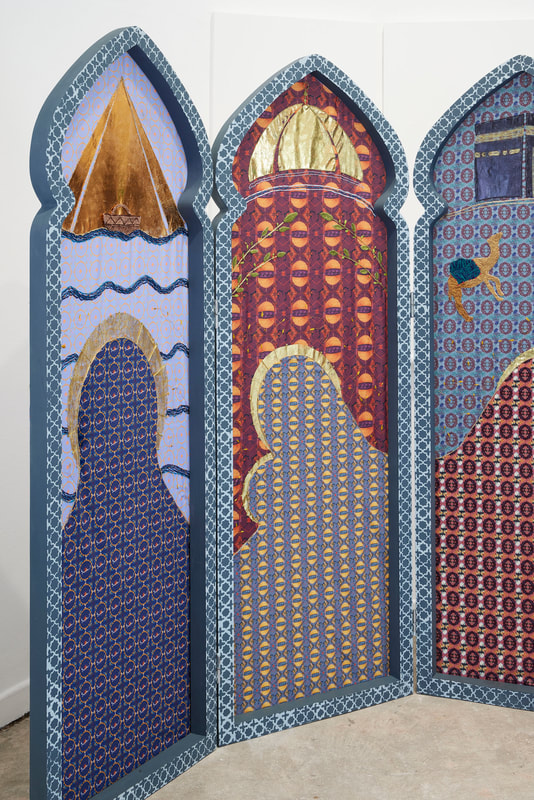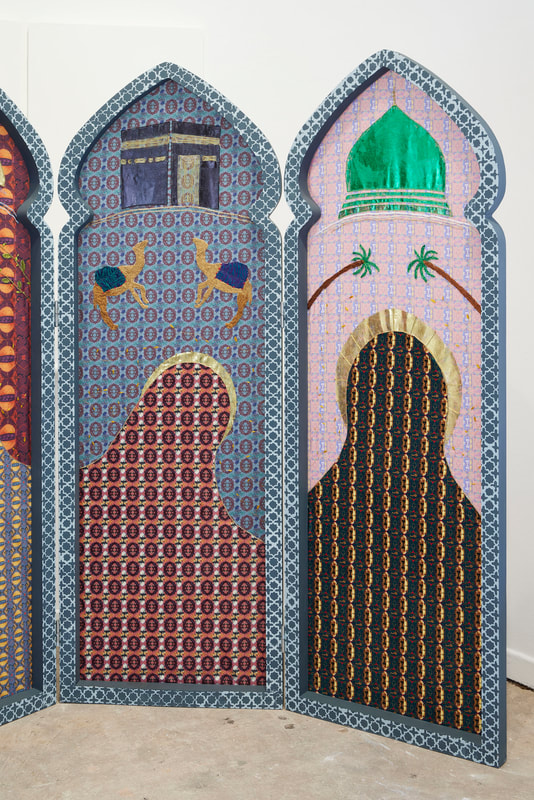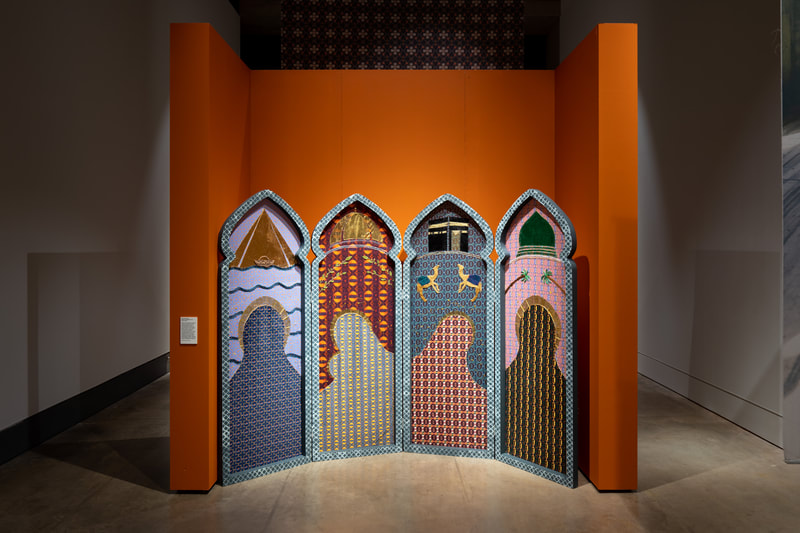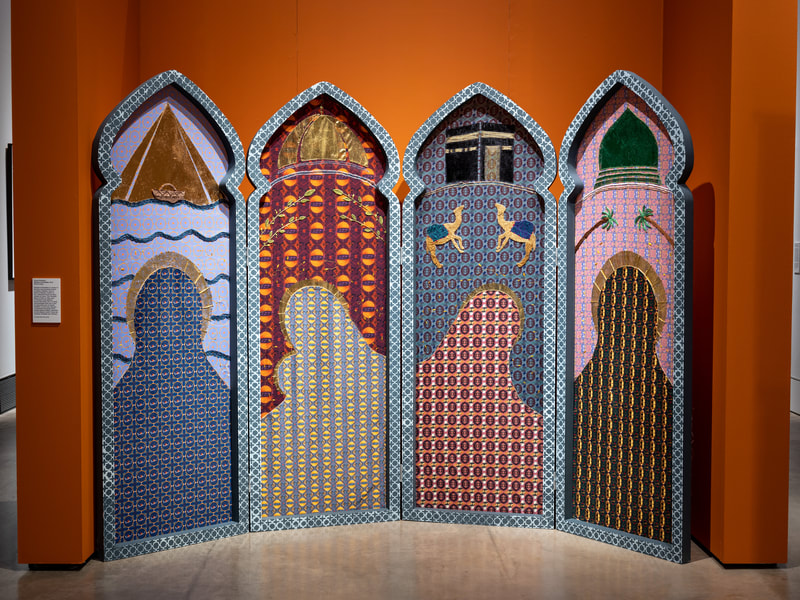Women of Paradise
2022
قَالَ رَسُولُ اللَّهِ ص أَفْضَلُ نِسَاءِ أَهْلِ الْجَنَّةِ أَرْبَعٌ خَدِيجَةُ بِنْتُ خُوَيْلِدٍ وَ فَاطِمَةُ بِنْتُ مُحَمَّدٍ وَ مَرْيَمُ بِنْتُ عِمْرَانَ وَ آسِيَةُ بِنْتُ مُزَاحِمٍ امْرَأَةُ فِرْعَوْنَ
The prophet (s.a.w.) is narrated to have said “The best of the women of paradise are Khadijah bint Khuwaylid, Fatimah bint Muhammad, Maryam bint Imran and Aasiyah bint Muzahim, the wife of Pharaoh” Source: Kitab al-Khisal, vol. 1 pg 206 Sunan Nasai, vol. 5 pg. 93 hadith 8355.
Women of Paradise (2022) is a response to the singular religious narratives that dominate museums and galleries. Built on principles of neutrality, these spaces rarely contain depictions of Mary outside of the Christian imagination. Moledina’s work interrogates this assumption of neutrality by providing a different perspective on this figure. In the work, Maryam (a.s.) – a subject of equal cultural significance in the East – is presented alongside three female figures largely unfamiliar to the Western world. These are Aasiyah (a.s.), Khadijah (a.s.) and Fatimah (a.s.).
Moledina’s work comprises four wooden frames hinged together around digitally printed textile and embroidery. The arched frames resemble a Mihrab – a niche found in the walls of mosques that indicates the direction of prayer. The textiles and embroidery are composed of patterns relating to the women who are represented and are inspired by principles of Islamic design such as recurrence, symmetry and abstraction.
This work is dedicated to the memory of Farwa Moledina’s late aunt Fatima, who passed away in April 2022 and was named for one of the four women of paradise. She was Farwa’s foremost mentor and actively fostered her creativity from a young age.
Farwa Moledina, Women of Paradise (2022), Textile installation, 200cm x 280 cm approx. Ikon Gallery. Images: Stuart Whipps
Farwa Moledina, Women of Paradise (2022), Textile installation, 200cm x 280 cm approx. The Wilson Museum and Art Gallery. Images: Luke Unsworth
2022
قَالَ رَسُولُ اللَّهِ ص أَفْضَلُ نِسَاءِ أَهْلِ الْجَنَّةِ أَرْبَعٌ خَدِيجَةُ بِنْتُ خُوَيْلِدٍ وَ فَاطِمَةُ بِنْتُ مُحَمَّدٍ وَ مَرْيَمُ بِنْتُ عِمْرَانَ وَ آسِيَةُ بِنْتُ مُزَاحِمٍ امْرَأَةُ فِرْعَوْنَ
The prophet (s.a.w.) is narrated to have said “The best of the women of paradise are Khadijah bint Khuwaylid, Fatimah bint Muhammad, Maryam bint Imran and Aasiyah bint Muzahim, the wife of Pharaoh” Source: Kitab al-Khisal, vol. 1 pg 206 Sunan Nasai, vol. 5 pg. 93 hadith 8355.
Women of Paradise (2022) is a response to the singular religious narratives that dominate museums and galleries. Built on principles of neutrality, these spaces rarely contain depictions of Mary outside of the Christian imagination. Moledina’s work interrogates this assumption of neutrality by providing a different perspective on this figure. In the work, Maryam (a.s.) – a subject of equal cultural significance in the East – is presented alongside three female figures largely unfamiliar to the Western world. These are Aasiyah (a.s.), Khadijah (a.s.) and Fatimah (a.s.).
Moledina’s work comprises four wooden frames hinged together around digitally printed textile and embroidery. The arched frames resemble a Mihrab – a niche found in the walls of mosques that indicates the direction of prayer. The textiles and embroidery are composed of patterns relating to the women who are represented and are inspired by principles of Islamic design such as recurrence, symmetry and abstraction.
This work is dedicated to the memory of Farwa Moledina’s late aunt Fatima, who passed away in April 2022 and was named for one of the four women of paradise. She was Farwa’s foremost mentor and actively fostered her creativity from a young age.
Farwa Moledina, Women of Paradise (2022), Textile installation, 200cm x 280 cm approx. Ikon Gallery. Images: Stuart Whipps
Farwa Moledina, Women of Paradise (2022), Textile installation, 200cm x 280 cm approx. The Wilson Museum and Art Gallery. Images: Luke Unsworth





